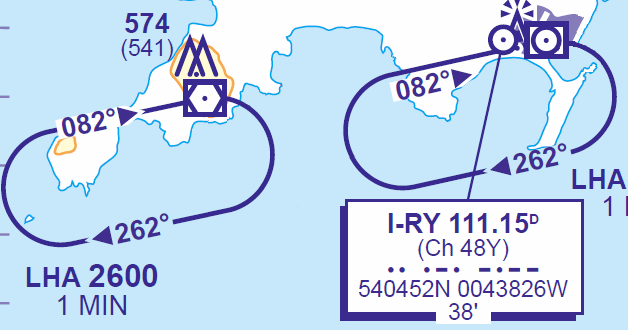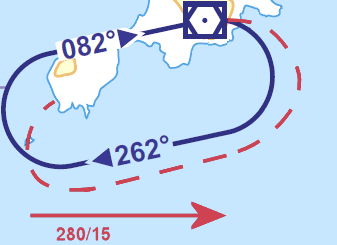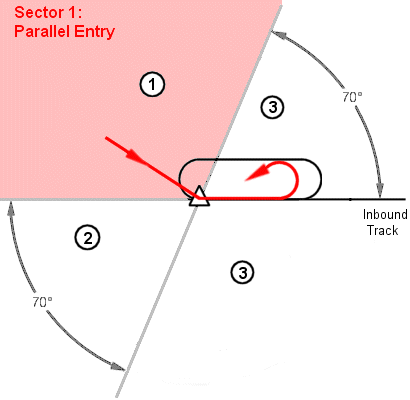






Procedural Instrument Approaches
Part 4
Holding Patterns
For many FS pilots a hold is something unpleasant, maybe unknown and probably a bit daunting. It need not be.

A hold is simply a means of delaying aircraft in an orderly fashion. Usually they are stacked in the hold at 1000ft intervals with the aircraft at the bottom of the stack being the next to start the procedure when this is possible.
There are two processes to learn for the hold. One is the holding procedure itself and the other is the means of getting into it in the first place - the hold entry procedure.
The Hold
Holding patterns are time based procedures so a stopwatch or clock with a second hand is very, very useful to have.
The normal hold is a 4 minute procedure describing a racetrack pattern. In the case of the hold shown above it starts with the aircraft passing over the holding facility (IOM VOR) and turning right onto 262. This is a Rate 1 turn and will take 1 minute. When steady on 262 the outbound leg is also flown for 1 minute and then a right turn is made back onto 082. Again this is Rate 1 taking another minute and the aircraft will then fly 082 back to the VOR completing a four minute pattern.
Some holds are 6 minutes and in these cases the outbound leg and inbound leg are extended to 2 minutes. Some holds are left hand patterns and some holds may be right hand patterns.
Essentially that is it - but nothing is easy in flying. The headaches start to appear when there is some wind about - and learning how to correct for this. To be honest I won't describe this here as there are better online tutorials that cover correction calculations - but I'll illustrate why a pilot should be aware of the effects of wind.

Above you see what happens with a westerly wind. As the aircraft starts to turn outbound in the pattern the wind drifts it too far east. On the outbound leg the aircraft will drift slightly south and this leg will end up shorter than normal (flying into a headwind). The inbound turn will be tighter so the aircraft will finish the turn south of track and much closer to the VOR than expected. This will end up as a 3:30 pattern or less.

If the wind is across the pattern the effect is more difficult to correct. With a southerly wind the initial outbound turn is shortened because of turning into a headwind. The outbound leg will see the aircraft drifting further north of track and the inbound turn is extended as the aircraft now has a tailwind. The result is that the aircraft can end up substantially north of the inbound track of 082.
Drift Correction
The solution to holding pattern problems is to assess the drift and correct for it. As you can't correct for drift in the turns all the correction has to be applied on the outbound leg and so this is flown at 3 x drift angle - resulting in a pear shaped pattern rather than the more normally expected racetrack. The result should be that when completing the inbound turn you should be correctly aligned on the inbound radial/track and should fly this to the navaid with the normal drift angle applied.
If you are lucky and have initially approached the navaid on the inbound heading you should already have worked out the drift angle from your heading against the flown radial. For any other approach direction some calculation is needed and the drift angle can be determined by using the formula windspeed / TAS x 60. So for a 25kt crosswind and a TAS of 150kts the drift angle is 10 degrees. In the above pattern the inbound leg would be flown on 092 and the outbound leg on 232.
Where the wind is down the hold as in the first example very little drift is encountered but the wind may make the outbound leg shorter than required (say a headwind as in the diagram) or it may be longer if there is a tailwind. To correct for this a rough guide is to increase or decrease the outbound leg time by one second for every knot of windspeed. The top diagram shows a wind of 280/15kt so the outbound leg is going to be too short. In this case you would increase the leg time from 1:00 to 1:15 (75 seconds) before starting the inbound turn.
Hold Entry Procedures
I say procedures because there are three of them. All are based on the teardrop pattern described earlier and there are three because it depends on the direction you approach the hold - this being the same headache as the direct entry to a procedure.
Before describing each procedure I must take time to explain the hold entry chart.

Take a few minutes to familiarise yourself with the diagram. Note the inbound track to the hold and the holding pattern direction. This is a typical hold entry diagram so it requires a little agility to relate it to a specific hold you may be intending to fly - it can be awkward mentally rotating it to the correct inbound heading.
The diagram shows the three sectors for the different entry procedures. I have colour coded these for clarity. As the IOM hold is from the opposite direction the example above the image requires rotating 180 degrees to make sense. So let's do this to make the first example easier to visualise.

The inbound heading for the hold is 082 so we can work out the headings for the three sectors.
Aircraft flying to the VOR on a heading between 012 and 192 fly a Sector 3 entry.
Aircraft flying to the VOR on a heading between 192 and 262 fly a Sector 2 entry.
Aircraft flying to the VOR on a heading between 262 and 012 fly a Sector 1 entry.
The above may sound complex but it's harder to explain on page than it actually is. Look back at the IAP and you will find that the entry procedures are easy to visualise in most cases. Using the above diagram it is not hard to see that aircraft from Dublin (W911D), Glasgow (W928D) and Belfast (L10) would fly Sector 3 entries, aircraft from Liverpool and the SE (L10 AND W2D) would fly Sector 1 entries and aircraft from Carlisle or Newcastle (W911D) would fly a Sector 2 entry.
Now we need to know the actual entry procedures.
Sector 1 - Parallel Entry

With a Sector 1 procedure the aircraft crosses the facility and flies the reciprocal of the inbound heading for 1 minute (or 1.5 minutes if a 6 min hold). A Rate 1 turn is then made back to the facility and the hold is started.
Sector 2 - Reverse Entry

With a Sector 2 procedure the aircraft flies a teardrop as we have used earlier - flying an offset of 30 degrees from the reciprocal heading for the hold. After 1 min (or 1.5 min) a Rate 1 turn is made back onto the inbound heading of the hold back to the facility.
Sector 3 - Direct Entry

With a Sector 3 procedure the aircraft enters the holding pattern directly.
Non of the entry procedures are hard to fly. The difficulty lies with identifying the correct entry procedure for you inbound direction and working out the headings needed. It need not be said that the first few attempts will be difficult but as you repeat the exercise it starts to become more familiar and the mental workload decreases.
Start off by picking one holding pattern and keep flying this until you are happy with it. Work through all three entry procedures so that they become familiar and you become confident with what you are doing. When you are happy with this try a different facility - maybe the CAR hold.
If you practise initially with a VOR or NDB you have the advantage of seeing a needle in the cockpit show you are passing overhead the navaid. Holds at fixes are slightly more difficult in that you are usually looking for a DME reading to indicate the position. It can help in that more modern cockpits now have GPS to help visualise the situation.

